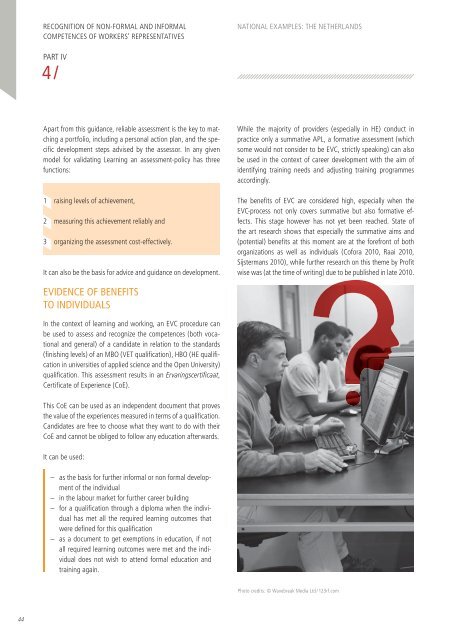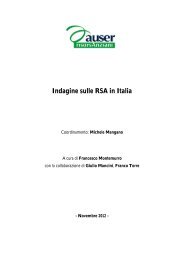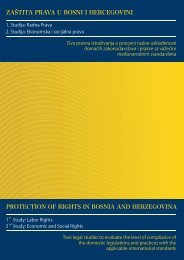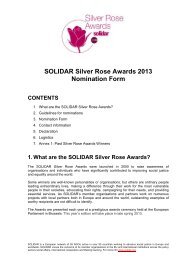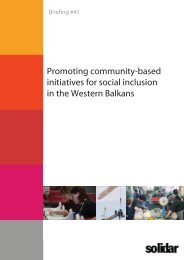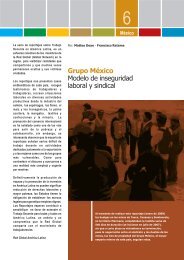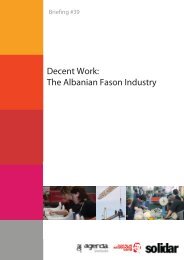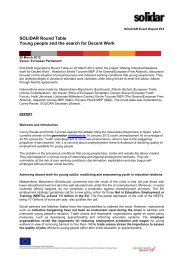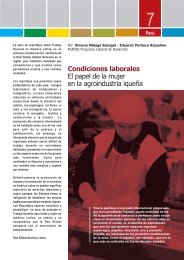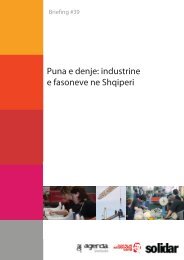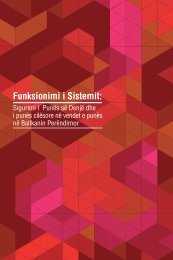RECOGNITION OF NON-FORMAL AND INFORMAL ... - Solidar
RECOGNITION OF NON-FORMAL AND INFORMAL ... - Solidar
RECOGNITION OF NON-FORMAL AND INFORMAL ... - Solidar
You also want an ePaper? Increase the reach of your titles
YUMPU automatically turns print PDFs into web optimized ePapers that Google loves.
<strong>RECOGNITION</strong> <strong>OF</strong> <strong>NON</strong>-<strong>FORMAL</strong> <strong>AND</strong> IN<strong>FORMAL</strong><br />
COMPETENCES <strong>OF</strong> WORKERS’ REPRESENTATIVES<br />
NATIONAL EXAMPLES: THE NETHERL<strong>AND</strong>S<br />
PART IV<br />
4 /<br />
Apart from this guidance, reliable assessment is the key to matching<br />
a portfolio, including a personal action plan, and the specifi<br />
c development steps advised by the assessor. In any given<br />
model for validating Learning an assessment-policy has three<br />
functions:<br />
1 raising levels of achievement,<br />
2 measuring this achievement reliably and<br />
3 organizing the assessment cost-effectively.<br />
It can also be the basis for advice and guidance on development.<br />
While the majority of providers (especially in HE) conduct in<br />
practice only a summative APL, a formative assessment (which<br />
some would not consider to be EVC, strictly speaking) can also<br />
be used in the context of career development with the aim of<br />
identifying training needs and adjusting training programmes<br />
accordingly.<br />
The benefi ts of EVC are considered high, especially when the<br />
EVC-process not only covers summative but also formative effects.<br />
This stage however has not yet been reached. State of<br />
the art research shows that especially the summative aims and<br />
(potential) benefi ts at this moment are at the forefront of both<br />
organizations as well as individuals (Cofora 2010, Raai 2010,<br />
Sijstermans 2010), while further research on this theme by Profi t<br />
wise was (at the time of writing) due to be published in late 2010.<br />
EVIDENCE <strong>OF</strong> BENEFITS<br />
TO INDIVIDUALS<br />
In the context of learning and working, an EVC procedure can<br />
be used to assess and recognize the competences (both vocational<br />
and general) of a candidate in relation to the standards<br />
(fi nishing levels) of an MBO (VET qualifi cation), HBO (HE qualifi -<br />
cation in universities of applied science and the Open University)<br />
qualifi cation. This assessment results in an Ervaringscertifi caat,<br />
Certifi cate of Experience (CoE).<br />
This CoE can be used as an independent document that proves<br />
the value of the experiences measured in terms of a qualifi cation.<br />
Candidates are free to choose what they want to do with their<br />
CoE and cannot be obliged to follow any education afterwards.<br />
It can be used:<br />
– as the basis for further informal or non formal development<br />
of the individual<br />
– in the labour market for further career building<br />
– for a qualifi cation through a diploma when the individual<br />
has met all the required learning outcomes that<br />
were defi ned for this qualifi cation<br />
– as a document to get exemptions in education, if not<br />
all required learning outcomes were met and the individual<br />
does not wish to attend formal education and<br />
training again.<br />
Photo credits: © Wavebreak Media Ltd / 123rf.com<br />
44


